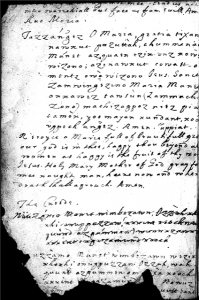Welcome to our newest feature at the Museum, the Language of the Month! A question that we frequently hear is “How does one dedicate a museum to an abstract idea?” While that may be an interesting philosophical question, it’s more than possible! Data collection, restoration projects, ephemera (dictionaries, Bibles, etc.) are all tools of languages and help document not only the language, but also its people and its customs.
As a natural extension of this documentation, we have also decided that each month, we will do an in-depth look of a less commonly taught or known language, known as our Language of the Month. We will look at languages from around the world, old and new, spoken and dormant, studied and not, to bring you a further understanding of languages and what they truly are.
As most of you know, our main establishment, including our storage and the space where our events are held, is in College Park, MD. Therefore, we have decided to focus on Piscataway, the indigenous language most likely spoken in the area before the arrival of the colonials in the 17th century.

Piscataway is a member of the Algonquian family of languages, which include Nanticoke, Delaware, and Mi’qmak, just to name a few of the more well-known languages. It is most closely related to Powhatan, another language from the tidewater region of Virginia.
Piscataway has 20 distinct phonemes, including 8 vowel sounds. The language has features many examples of prefixes and words combined together to describe abstract concepts that would take English several words or even sentences, similar to other Algonquian languages.
Unfortunately, Piscataway, also known as Conoy, is considered a sleeping language; although it is not completely extinct, meaning we have no evidence of it, there are also no fluent speakers of the language currently living. Our main source of Piscataway comes from a Bible translated by a Christian missionary named Father White (fragment pictured here), who accompanied Cecil Calvert to what is now Maryland in the 17th century. Here is where they encountered the Piscataway people, and underwent an effort to communicate with them, and successfully interpreted several concepts that are documented to this day, such as the existence of one god (or sky) and their reverence for the corn plant.
Although Piscataway is not the best documented of the indigenous languages, the translated Bible and the story of the encounters with the tribe help shape early language documentation and the history of indigenous tribes and colonization of Maryland. As we continue our celebration of the Year of Indigenous Languages, it’s important to think about languages we have lost in addition to preserving those that we can.
Sources:
Fragments of Piscataway: A Preliminary Description (https://pure.mpg.de/rest/items/item_407325_5/component/file_407324/content)
Native Languages (http://www.native-languages.org/wordalg.htm)
Language of the Month is an ongoing feature, focusing on lesser-known and underserved languages from around the world. If you are an expert or would like to contribute, please email rob@languagemuseum.org
